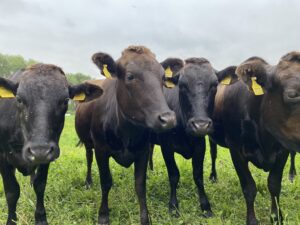Sepa Wagyu operates in Elbu village, Tori municipality, Pärnu County. Sepa is a traditional Estonian farm, revitalized in 2015. We started farming with 20 hectares of land, and our first purebred Limousin heifers arrived from Germany in 2016, along with a bull from Topi Mõis.
We run the farm as a family. We have two daughters: 12-year-old Elis Isabella and 10-year-old Katariina. Lisanna, the farm wife, takes care of the daily animal husbandry. Marko, the farm husband, also manages Linnamäe Meat Processing Plant and is a board member of the Estonian Beef Breeders Association.
Both of us studied beef cattle farming at the Järvamaa Vocational Education Center and have completed insemination courses. However, we believe that practical experience and learning from other farmers have taught us the most. We visit other farms, communicate with breeders, and learn how they do things. We also share our own experiences.
In beef cattle farming, we focus on breeding, primarily with full-blooded Wagyus. We also have a small herd of Limousins and Aberdeen Angus. We use both natural and artificial insemination. Our Wagyus come from several different farms in Germany, where breeding has been carried out for years. Additionally, we have been organic since 2023.
We aim for innovative, environmentally conscious farming and want to contribute to the development of the entire beef cattle sector. We have carefully selected all our animals. Unlike typical herds with many offspring from the same parents, most of our Wagyus have diverse genetics. For us, a diverse genetic base is crucial for breeding. Our farm’s innovation and environmental awareness are also reflected in our transition from continuous grazing to rotational grazing. This allows plants to recover after each short grazing cycle, improving pasture productivity. We use the rotational grazing method. Our nearly 100-head herd is divided into two groups. Each group has access to a roughly one-hectare paddock for two to three days before moving to the next, leaving the previously grazed paddock to rest for about 30 days. Each group has about 15 one-hectare paddocks, and the timing and location of grazing are planned using the Pasturemap software.
Awards: “Best Farm 2023”, “Tori Municipality Company of the Year 2023”, “Best Breeder 2025”, “Farmer of the year 2025” nominee.